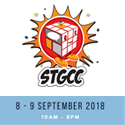ARCHIVING A GRAPHIC NOVEL: An Interview with Ivy Noelle Weir & Steenz
Members of The Valkyries, Ivy Noelle Weir and Steenz (AKA Christina Stewart), have joined forces for their Oni Press graphic novel ARCHIVAL QUALITY. Now, named as a Junior Library Guild selection, FlipGeeks had a chance to interview with the duo.
FLIPGEEKS: Who are Ivy Noelle Weir and Steenz?
IVY NOELLE WEIR: I’m a writer and visual artist from Philadelphia, Pennsylvania. I’ve been writing my entire life, but Archival Quality is my first graphic novel!
STEENZ: My name is Steenz! It’s short for Christina. I am a comic illustrator as well as a social media manager for Lion Forge Comics.

How did you come up with the story of Archival Quality? What is it about?
WEIR: I came up with the initial idea for the book while I was working as an intern in a medical history museum, like the one in our book (thankfully, modern museums like this in real life are not haunted, not creepy, and totally ethical in how they source materials!). I wanted to write a ghost story that incorporated my love and museums, libraries (I have a master’s degree in library science) and haunted house stories. So I started writing the story of Celeste Walden, who comes to work in a haunted library, and I found it to be a really cathartic way to explore my academic interest in libraries and archives with my absolute love of ghost stories and horror. I also wanted it to be a character driven story, and for readers to empathize with our ghost, and so the ties between Cel and the ghost she is striving to save are very emotional.

The main character is Celeste Walden. She has depression. What kind of research did you do? Did you have any personal experience with it?
WEIR: I’ve struggled with some form of depression and/or anxiety since I was a young teenager. Like Cel, over the years, different therapists assigned it different diagnoses and treatments, and it wasn’t until I was in my mid-twenties that I found someone who wasn’t quick to label me and instead wanted to focus on tools to manage it (which honestly saved my life). It was really important to me to portray in Cel a person who is struggling with these things, but is learning to manage — I really didn’t want it to seem like a plot device, I wanted it to be part of her, and I wanted her not to be “fixed” at the end of the book, but instead learning how to live with it and manage.
What made you want to write this story? What emotions and ideas do you want people have when they’re done reading Archival Quality?
WEIR: This story had been rattling around in my head for years before I actually wrote it down. I am fascinated by the power dynamics of archives, and I am obsessed with haunted house stories, and I wanted to create something that blended the two. In Cel and her friends, I also wanted to create a strong, character-driven story about feeling lost in your early twenties. I hope people walk away from Archival Quality feeling thoughtful: about their own relationships and their relationship with the archives present in their own lives.
How did you learn to draw comics and how long have you been drawing comics, Steenz?
STEENZ: I’ve always drawn digitally with Photoshop and Clip Studio. I started using Photoshop for art as early as the 2000s. But when it came to comics specific knowledge, I am self taught!
I’ve been drawing comics since 2012. That’s about when I started getting them printed!
Did you have any formal studies?
STEENZ: I went to school for Studio Art – Illustration. There I got a lot of my basic drawing knowledge. Figure drawing, color theory, etc.
How did you two meet and start working on Archival Quality?
STEENZ: Ivy and I knew each other from The Valkyries. It’s a Facebook group of women who work in comics retail. We’d become closer and then she asked if I wanted to do a comic with her and I was like absolutely!
WEIR: I had been working on Archival Quality as a prose novel, but after I saw Steenz post her art in the group a few times, I knew I wanted to do something with her. I reached out and basically asked her out on a graphic novel date. I am very lucky she accepted!
Steenz and I submitted ten pages of Archival Quality to Oni Press during their open submissions period, and that’s how this book got made. Other than that, my involvement in The Valkyries was really my gateway to comics — I went from working a part-time job in a comic shop to writing them. Pretty cool.

What is the collaboration between you two?
STEENZ: Collaboration with Ivy is great. Even though we live in different states and time zones, we’re in the habit of keeping in touch through Facebook Messenger pretty much all day every day. And being able to reach out to her like that and to Skype and to call makes it easier to run through ideas and thumbnails together. Also we our thought process is usually very complimentary so working with her is usually quite easy.
WEIR: I had never written a comic script before (lots of prose, but no comics), and so the writing process was a lot of: HELLO AM I DOING THIS RIGHT?? PLEASE HELP. I owe a life debt to our editor, Robin Herrera, who was so fantastic during the whole process. I think our process is also unique because Steenz and I talked pretty much constantly throughout — she would be drawing and send me panels, or I would be writing and send her pieces of script, and we would work together to figure out how things should work.
The characters in Archival Quality are a vast array of different kinds of people from different ethnicity, backgrounds, and sexual orientations. What made you want to have this particular cast of characters? Are these characters based on, or inspired by people in your life?
WEIR: There are parts of Cel and her relationships that do hit very close to home for me, when I was younger. But overall, even if I started with real-life inspirations for these characters, they grew and became their own people over time. Steenz and I worked on a lot of this collaboratively: when I approached her with the script, I had no set descriptions for the characters, and she designed a beautifully diverse cast that perfectly embodied what I had envisioned. It’s so unrealistic to have a book that doesn’t have a diverse cast– that’s not real life.
What is your art process like?
STEENZ: I usually will read the script for a page, do a thumbnail for what Iwant the layout to be. If there are some edits that need to be made for where the speech bubbles will be and the flow of story-telling, I’ll do that in the thumbnail stage. Then I’ll move over to Clip Studio and pencil the pages, ink them there, and then color in Photoshop!
Do you have a day job or work outside making comics? If so, how do you balance work while making comics?
WEIR: I work in publicity and marketing for a book publisher now, but for the majority of writing this book, I was a public librarian. I have a routine for writing: I get up at 5:00 AM every day, I make coffee, and I write for two hours before I have to get ready for work. It kind of sucks — who likes getting up that early? — but it has really helped me stay on task with writing.
Did you use any reference for this book, like for the characters, sets? Were you provided or did you have to provide it from yourself?
STEENZ: Ivy left all the character design to me. So I have pages of designs for each of the characters based on what I wanted to see in the comics industry. Which is why our three main characters are all POC! As for photo references for posing, I either used myself or my fiancé.
What genre do you like to draw? How challenging is it to draw a story like Archival Quality?
STEENZ: I like to draw stories that take place in real life. Not really a fan of drawing sci-fi/fantasy, just because my imagination doesn’t exactly stretch that far. Day in the life is what’s easiest for me. So drawing AQ was fun because even though it was a horror/mystery of sorts, it was still incredibly realist.

What things have you learned from this project?
STEENZ: I learned a LOT. I mean I learned everything from panel structure to storytelling with purpose… I learned a lot of technical drawing skills and that all came from drawing every single day for about 2 years. Comics will really put your artistic skills to the test.
What comics do you read and why do you like to read them?
WEIR: Oh, I read everything. My all-time favorite series is the original Hellboy comics by Mike Mignola (especially, the vignette collection The Chained Coffin and Others). I just finished the BOOM! Studios series Godshaper and I really liked it — it had excellent magic and world building (and gorgeous art and colors). Other than that, I read a lot of the biggies: Saga, The Wicked + The Divine, etc… I like any story that has strong characters and character relationships over big action.
STEENZ: I read a lot of different comics. But I read Detective Comics, Descender, Misfit City, Extremity… Also graphic novels like Generations, This One Summer, and lots of Junji Ito manga! I love super-heroes. That was my first foray into the comic scene and then I started reading more graphic novels that were memoirs or day in the life. I love those kinds of stories that are relatable. But I also like the artistry of horror manga!
After the release of Archival Quality, do you and Ivy have plans to work on another project together?
STEENZ: Yeah! We’re not totally sure what we’re going to do, but we definitely want to continue making comics together.
Archival Quality will be available at your nearest local comic book store/book store this March 7, 2018.









